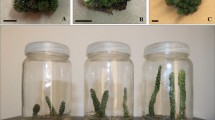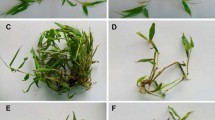Abstract
The possible use of in vitro shoot morphogenesis and shoot apex culture to evaluate salt tolerance in cultivated tomato (Lycopersicon esculentum Mill.) has been analyzed, using two cultivars with similar salt tolerance, Pera and Hellfrucht frühstamm (HF). The effect of salt on shoot regeneration was studied by culturing leaf explants on media supplemented with 0, 43, 86, 129 and 172 mM NaCl. The presence of NaCl in the regeneration media at 86 mM strongly inhibited shoot regeneration in the cultivar HF, but not in Pera. However, the substitution of NaCl by mannitol, maintaining the same water potential in the culture media, decreased the regeneration percentage in Pera but did not affect HF. Shoot apices of both cultivars were also subcultured at 6-week intervals, for 4 subcultures, at the same NaCl concentrations as used in the previous experiment, and the shoot growth, leaf and root number, rooted shoot and shoot necrosis were recorded at the end of each subculture. Root formation was the parameter most affected by salt in both cultivars, Pera being more sensitive than HF. The substitution of NaCl by mannitol significantly increased the percentage of rooted shoots in Pera after four subcultures, and slightly decreased this percentage in HF. Shoot necrosis was only observed in the last subculture at NaCl higher than 86 mM, the percentage of necrotic shoots being higher in Pera than in HF (75% and 45%, respectively). The lack of agreement between the results obtained with the in vitro tests, e.g., adventitious shoot formation and growth of apical stem sections, suggests that this approach may not be a reliable tool to evaluate salt tolerance in cultivated tomato.
Similar content being viewed by others
References
Cano EA, Pérez-Alfocea F, Moreno V & Bolarín MC (1996) Responses to NaCl stress of cultivated and wild tomato species and their hybrids in callus cultures. Plant Cell Rep. 15: 791–794
Cano EA, Pérez-Alfocea F, Moreno V, Caro M & Bolarín MC (1998) Evaluation of salt tolerance in cultivated and wild tomato species through in vitro shoot apex culture. Plant Cell Tiss. Org. Cult. 53: 19–26
Cruz V, Cuartero J, Bolarín MC & Romero M (1990) Evaluation of characters for ascertaining salt stress responses in Lycopersicon species. J. Amer. Soc. Hort. Sci. 115: 1000–1003
Epstein E (1976) Genetic potentials for solving problems of soil mineral stress: Adaptation of crops to salinity. In: Wright MJ (ed.) Plant Adaptation to Mineral Stress in Problem Soils (pp 73–82). Cornell University, New York
Gamborg OL, Miller RA & Ojima K (1968) Nutrient requirements of suspensions cultures of soybean root cells. Exp. Cell Res. 50: 151–158
García-Reina G, Moreno V & Luque A (1988) Selection for NaCl tolerance in cell culture of three Canary Island tomato land races. I. Recovery of tolerant plantlets from NaCl-tolerant cell strains. J. Plant Physiol. 133: 1–6
González-Fernández JJ (1996) Tolerancia a la salinidad en el tomate en estado de plántula y en planta adulta. PhD Thesis, Córdoba University, Spain
Kurtz SM (1981) Selection for sodium-chloride tolerant cell lines of Lycopersicon esculentum Mill. PhD Thesis, The Ohio State University, Columbus
Liu K-B & Li S-X (1989) In vitro flower formation in leaf explants of tomato: effect of NaCl. Planta 180: 131–133
Martínez CA, Maestri M & Lani EG (1996) In vitro salt tolerance and proline accumulation in Andean potato (Solanum spp.) differing in frost resistance. Plant Sci. 116: 177–184
McCoy TJ (1987) Tissue culture evaluation of NaCl tolerance in Medicago species: cellular versus whole plant response. Plant Cell Rep. 6: 31–34
Morpurgo R (1991) Correlation between potato clones grown in vivo and in vitro under sodium chloride stress conditions. Plant Breed. 107: 80–82
Murashige T & Skoog F (1962) A revised medium for rapid growth and bioassays with tobacco tissues cultures. Physiol. Plant. 15: 473–497
Pérez-Alfocea F, Estañ MT, Caro M & Bolarín MC (1993) Response of tomato cultivars to salinity. Plant Soil 150: 203–211
Pérez-Alfocea F, Gerrier G, Estañ MT & Bolarín MC (1994) Comparative salt responses at cell and whole-plant levels of cultivated and wild tomato species and their hybrid. J. Hort. Sci. 69: 639–644
Sánchez-Díaz M & Aguirreolea J (1993) Relaciones hídricas. In: Azcón-Bieto S & Talón M (eds) Fisiología y Bioquímica Vegetal (pp 49–90). Interamericana McGraw-Hill, Madrid
Sancho-Carrascosa MA (1994) Morfogénesis del tomate (Lycopersicon esculentum Mill.) cultivado in vitro. I. Organogénesis en disco de hoja (cv. Pera y Hellfrucht frühstamm). II. Establecimiento de líneas celulares en medio salino (cv. Pera). PhD Thesis, Málaga University, Spain
Saranga Y, Zamir D, Marani A & Rudich J (1993) Breeding tomatoes for salt tolerance: variations in ion concentrations associated with response to salinity. J. Amer. Soc. Hort. Sci. 118: 405–408
Tal M (1984) Physiological genetics of salt resistance in higher plants: studies on the level of the whole plant and isolated organs, tissues and cells. In: Staples RC & Toenniessen GH (eds) Salinity Tolerance in Plants. Strategies for Crop Improvement (pp 301–320). Wiley and Sons, New York
Tal M, Heikin H & Dehan K (1978) Salt tolerance in the wild relatives of the cultivated tomato: responses of callus tissue of Lycopersicon esculentum, L. peruvianum and Solanum pennellii to high salinity. Z. Pflanzenphysiol. 86: 231–240
White PR (1963) The Cultivation of Animal and Plant Cells. Ronald Press Co., New York
Author information
Authors and Affiliations
Rights and permissions
About this article
Cite this article
Mercado, J.A., Sancho-Carrascosa, M.A., Jiménez-Bermúdez, S. et al. Assessment of in vitro growth of apical stem sections and adventitious organogenesis to evaluate salinity tolerance in cultivated tomato. Plant Cell, Tissue and Organ Culture 62, 101–106 (2000). https://doi.org/10.1023/A:1026503603399
Issue Date:
DOI: https://doi.org/10.1023/A:1026503603399




